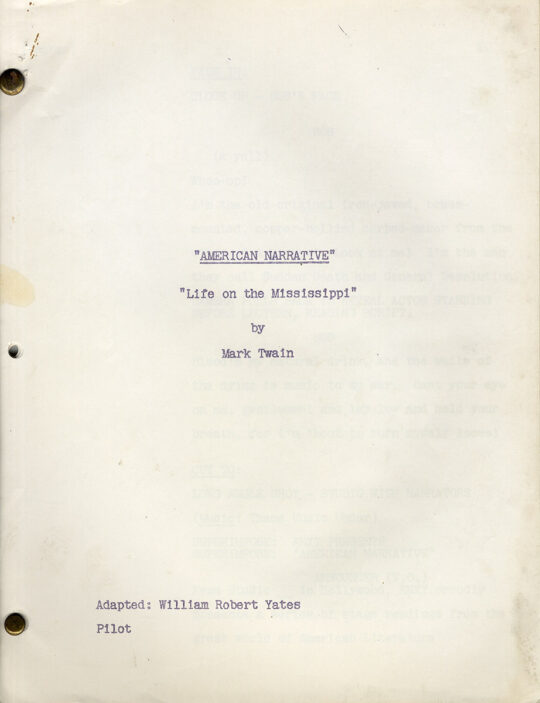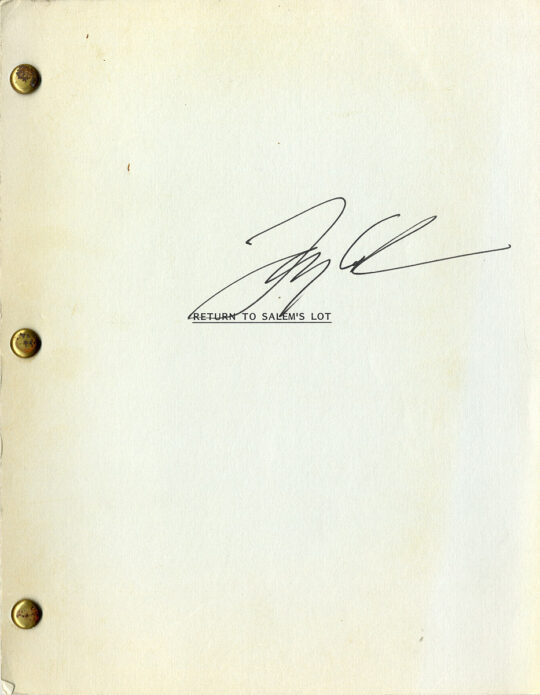Nicholas Pileggi (source, screenwriter), Martin Scorsese (screenwriter, director) GOODFELLAS [working title: WISEGUY] (1987) Film script
[New York]: Winkler Films, 1987. Vintage original film screenplay, 11 x 8 1/2″ (28 x 22 cm.), printed wrappers under working title WISEGUY, brad bound, 131 pp., just about fine.
Martin Scorsese’s Goodfellas (1990) was adapted by Scorsese and Nicholas Pileggi from Pileggi’s 1986 book Wiseguy: A Life in the Mafia Family, which told the allegedly true story of Mafia-mobster-turned-informant Henry Hill, played by Ray Liotta in the movie. Considered one of the greatest of all films in the crime genre, Goodfellas was nominated for six Academy Awards (winning Best Supporting Actor for Joe Pesci in the role of Tommy) and, in 2000, was selected for preservation in the National Film Registry by the United States Library of Congress as a work deemed “culturally, historically, and aesthetically significant”.
This 1987 early screenplay draft by Pileggi and Scorsese had the working title Wiseguy, and given Scorsese’s penchant for improvisation, it is surprisingly similar to what was ultimately filmed. Goodfellas, even more so than Scorsese’s Taxi Driver, Casino or The Wolf of Wall Street, is dependent on voiceover narration — most of it delivered by Ray Liotta as Henry — and what is remarkable about this 1987 draft is how virtually all of the screenplay’s narration is identical to what we hear in the movie. Scorsese has said that one of the main things that attracted him to this project was the way these characters talked (as transcribed by author Pileggi), and that is what he wanted to capture on film. Significantly, as soon as the character of Henry’s future wife Karen (Lorraine Bracco) is introduced, we begin to hear her voiceover as well. At one point in this draft there is even a voiceover from Paulie the mob boss (Paul Sorvino’s character), but his voiceover was omitted from the completed film.
There will always be differences between what is written in a script and how it is executed. One of Goodfella‘s signature sequences is the killing of Billy Batts (Frank Vincent), provoked by his asking Tommy (Joe Pesci) to get his “shine box” and concluding with the disposal of Batts’ corpse. The 1987 Wiseguy draft begins with this sequence in its entirety. However, the movie begins with only the tail end of this sequence — Henry, Tommy and Jimmy Conway (Robert De Niro) driving their car at night with Batts’ body in the trunk and discovering he is still alive, which leads to Tommy stabbing him and Jimmy shooting him repeatedly to make sure the hood is really dead. In the movie, we don’t see the first part of the sequence, the part where Batts provokes Tommy, until approximately halfway through the narrative, and it is considerably elaborated. In both the script and the film, Henry, Tommy and Jimmy stop by Tommy’s mother’s house to pick up a shovel (to bury Batts), but in the movie the mother insists on serving dinner to the three of them, and Tommy borrows a kitchen knife that he will later use to stab Batts.
One minor difference: Robert De Niro’s character, Jimmy Conway, is called Jimmy Burke in the 1987 draft.
One good reason for moving the Batts provocation scene to the middle of the film is that we have already seen how volatile Tommy’s character is in the “Am I a clown? Do I amuse you?” scene, and knowing how volatile Tommy is adds an element of suspense. We know Tommy is going to go ballistic on Batts; it’s only a matter of when. The “Am I a clown?” sequence is, incidentally, the only major sequence in the movie that does not appear in the 1987 screenplay, arising as it did out of a Joe Pesci improvisation that occurred during the movie’s rehearsals.
The famous Copacabana sequence — where Henry takes his girlfriend Karen to the prestigious nightclub, brings her in through a back entrance without waiting in line, weaves his way through the basement kitchen up to the showroom floor and is given a special table while being treated by everyone he meets like a prince, all shot in a single unbroken four-minute take — is in the 1987 script more or less as it plays, but there is no mention of it being filmed in a single take (though clearly Scorsese always intended to shoot it that way). Unlike many screenwriters, Scorsese rarely indicates camera angles or how a scene should be shot.
Another memorable sequence, the one in which Jimmy (De Niro) invites Karen to walk around the corner to pick out a fur coat and she suddenly panics, believing there might be somebody there waiting to kill her, is roughly the same in the movie as in the script, except in the 1987 script it is money she is supposed to pick up.
The screenplay divides neatly into two parts. Part one shows Henry’s rise in the Mafia and all the perks, the power and respect, the freedom and material benefits that go along with being a “wiseguy” or “goodfella”. Part two shows his fall — tied to greed and drug abuse — in which Henry and everyone around him become increasingly manic and paranoid, and friends start murdering each other. Another significant difference: in the script, Henry is dealing heroin, but in the movie he is dealing (and using) cocaine.
Out of stock
Related products
-

Mark Twain (source) LIFE ON THE MISSISSIPPI (ca. 1956) TV script adapted by William Robert Yates
$300.00 Add to cart -
![[Doyle, Arthur Conan (source work)]: "SHERLOCK HOLMES FIGHTS BACK" [released as: SHERLOCK HOLMES AND THE SECRET WEAPON] 22 May - 17 June 1942](https://www.walterfilm.com/wp-content/uploads/2018/10/SherlockHolmesFightsBack-Script1-540x724.jpg)
SHERLOCK HOLMES FIGHTS BACK [released as SHERLOCK HOLMES AND THE SECRET WEAPON] (May 22-Jun 17, 1942) Screenplay
$2,000.00 Add to cart -

RETURN TO SALEM’S LOT, A (1987) Larry Cohen-signed script
$625.00 Add to cart -

PAT AND MIKE (Jun 6, 1951) Film script by Ruth Gordon, Garson Kanin
$2,500.00 Add to cart

![GOODFELLAS [working title: WISEGUY] (1987) Film script](https://www.walterfilm.com/wp-content/uploads/2023/09/Goodfellas-1987SCR_a.jpg)
![GOODFELLAS [working title: WISEGUY] (1987) Film script](https://www.walterfilm.com/wp-content/uploads/2023/09/Goodfellas-1987SCR_b.jpg)
![GOODFELLAS [working title: WISEGUY] (1987) Film script](https://www.walterfilm.com/wp-content/uploads/2023/09/Goodfellas-1987SCR_c.jpg)